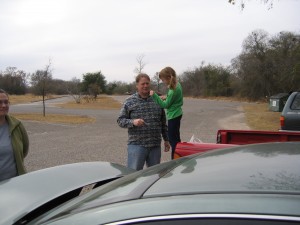May 1, 2012
 I am in the midst of final exam week and grading. In the background, Dr. Oz started talking about ‘paraben’ and how it acts as an estrogen. I am always on the alert for these kind of messages. Hormones, research, cancer, blood clotting… these all came to mind. I got up from the computer and went to listen carefully. And then I went to my bathroom. My shampoo have five kinds of paraben in it. My two different types of body lotions had multiple forms of paraben as well. I got rid of them. Trash. Not a moment’s hesitation.
I am in the midst of final exam week and grading. In the background, Dr. Oz started talking about ‘paraben’ and how it acts as an estrogen. I am always on the alert for these kind of messages. Hormones, research, cancer, blood clotting… these all came to mind. I got up from the computer and went to listen carefully. And then I went to my bathroom. My shampoo have five kinds of paraben in it. My two different types of body lotions had multiple forms of paraben as well. I got rid of them. Trash. Not a moment’s hesitation.
Why? Well, one of the facts Dr. Oz shared is that in one research study, 19 of 20 women diagnosed with breast cancer had significant levels of paraben in their breast tissue. I will hunt down the research and share it soon. For now, here is a summary of content from Dr. Oz with the link to the story at the end:
”
Flushed Away
We all know about industrial pollution and climate change, but there’s a new threat to the environment much closer to home – pharmaceutical and personal care product pollution (PPCP). Experts are increasingly worried that marine life across America is showing us the harm it’s doing to our planet and ourselves.
What’s Happening to the Environment?
In river basins around the country, the United States Geological Survey has found fish with both female and male sex organs. Intersex frogs are also popping up all over. And experts have found evidence of chemicals called endocrine disruptors, such as atrazine (an herbicide) and Bisphenol-A (BPA) in the country’s water supplies.
What are Endocrine Disruptors?
These chemicals alter the actions of hormones in our body, which can hurt us in 2 ways. First, they can block our hormones from acting as they normally would, and, secondly, they can act like hormones triggering effects that may include early onset puberty in adolescents.
What’s Happening to Us?
Breast cancer rates are increasing, girls are entering puberty earlier, sperm counts and testosterone levels are falling drastically, and certain genital abnormalities are on the rise.
What Should We Watch Out For?
Though the evidence is not definitive, experts fear that products we are introducing into our environment could be to blame, and they are urging us to decrease the use of certain chemicals. Here’s what to look for:
Bisphenol-A (BPA)You may have heard about BPA, the chemical used to make hard plastics, line cans, and create carbonless receipts. It’s proven to raise the risk of breast cancer in rats and the FDA has raised an alarm about the potential harm BPA can cause; Connecticut even banned its use in children’s products.
Ninety-three percent of us have BPA in our bodies. We live with it, and we excrete it when we go to the bathroom, sending the chemical into the environment.
[ pagebreak ]
Phthalates
These difficult-to-pronounce ingredients help fragrance linger on the body after you have applied a lotion or body cream to your skin. They’re also found in toys, floor coverings, detergent, soaps, nail polish, and shampoos. Unfortunately, they mimic the hormone estrogen and have been linked to reproductive problems in rodents, such as lower testosterone and fetal malformation. Often they are not listed on beauty products, so the best rule of thumb is to avoid any products with fragrance.
Parabens
Found in moisturizing shampoos and body lotions, parabens are the most widely used preservatives in the beauty product industry, and they also act similar to estrogen in our bodies. One study found parabens in the breast cancer tissue of 19 out of 20 women studied; experts worry there could be a connection.
Use these chemicals as a litmus test for a healthy product. If you see them listed on the label (often as methylparaben, butylparaben, or propylparaben), it shows that the manufacturer is not concerned about limiting exposure to potentially harmful chemicals.
Leftover Prescription Medicine
The medication we take ends up in our water supply in 1 of 2 ways. We secrete it in our urine (which we can’t control), but many of us also flush unused medication down the toilet, contributing to the rising amount of pharmaceutical pollution found in our water supply. In 2008, the Associated Press found that dozens of pharmaceuticals end up in our water supplies, and eventually, in our tap water. That’s because water treatment plants are designed to neutralize biological hazards, such as bacteria, but not pollutants such as antibiotics. Scientists are now discovering bacteria in the wild that are not only resistant to antibiotics, they can actually live off them.
What Can You Do?
- Drink water from stainless steel bottles
- Avoid plastics with the numbers 3, 6, and 7 on the bottom
- Never heat plastic in the microwave (even if it says it is microwave safe)
- Choose frozen and fresh produce over canned
- Use BPA-free baby bottles
- Avoid any products that contain fragrances; opt for those that get their scent from essential oils
- Stay away from parabens
- Choose products that are paraben- and phthalate-free
- Dispose of leftover medication by throwing it in the trash with coffee grinds or cat litter (to keep harmful medications from being picked from the trash), return the unused portion to your pharmacy, or go online to find your local hazardous waste disposal facility.”









